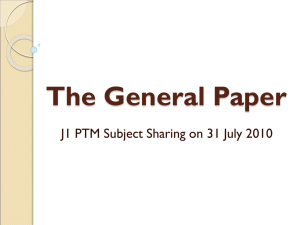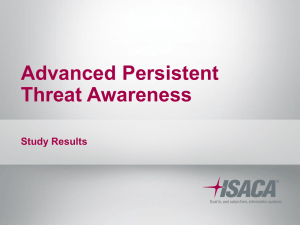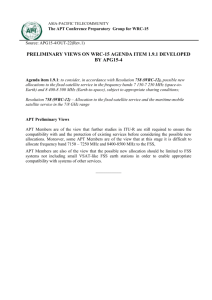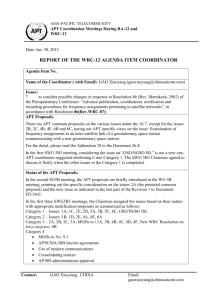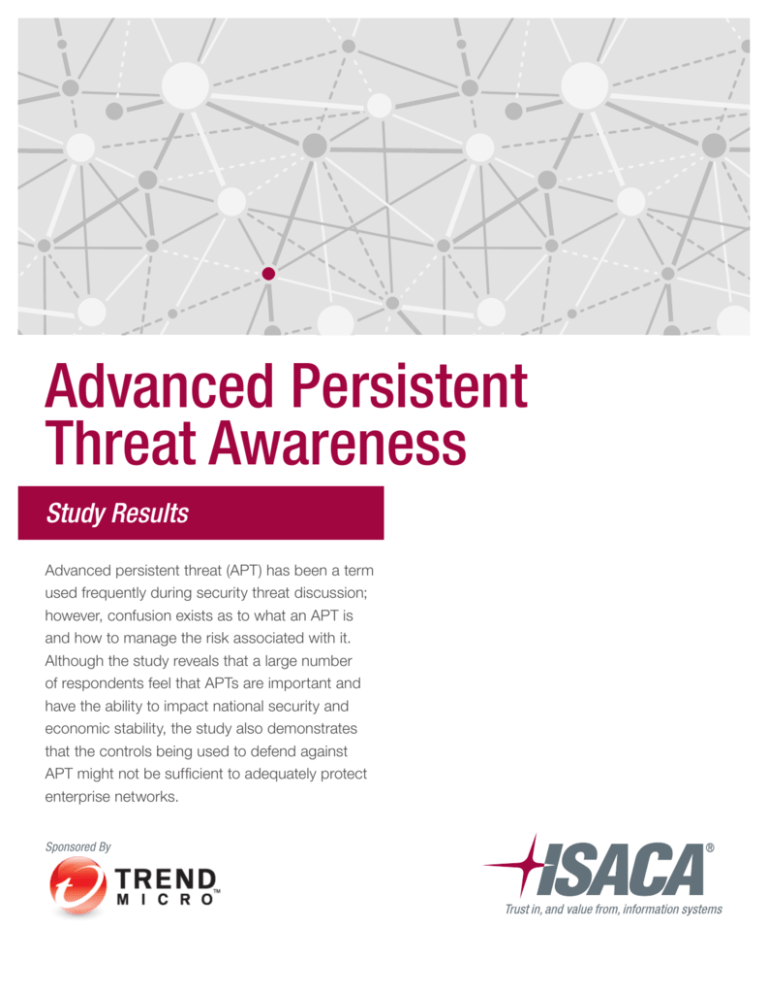
ADVANCED PERSISTENT THREAT AWARENESS
STUDY RESULTS
Advanced Persistent
Threat Awareness
Study Results
Advanced persistent threat (APT) has been a term
used frequently during security threat discussion;
however, confusion exists as to what an APT is
and how to manage the risk associated with it.
Although the study reveals that a large number
of respondents feel that APTs are important and
have the ability to impact national security and
economic stability, the study also demonstrates
that the controls being used to defend against
APT might not be sufficient to adequately protect
enterprise networks.
Sponsored By
© 2013 ISACA. ALL RIGHTS RESERVED.
1
ADVANCED PERSISTENT THREAT AWARENESS
STUDY RESULTS
ISACA®
With more than 100,000 constituents
in 180 countries, ISACA (www.isaca.org)
is a leading global provider of
knowledge, certifications, community,
advocacy and education on
information systems (IS) assurance
and security, enterprise governance
and management of IT, and IT-related
risk and compliance. Founded in 1969,
the nonprofit, independent ISACA
hosts international conferences,
publishes the ISACA® Journal, and
develops international IS auditing
and control standards, which help
its constituents ensure trust in, and
value from, information systems. It
also advances and attests IT skills
and knowledge through the globally
respected Certified Information
Systems Auditor® (CISA®), Certified
Information Security Manager ®
(CISM ®), Certified in the Governance
of Enterprise IT® (CGEIT®) and
Certified in Risk and Information
Systems Control TM (CRISCTM)
designations.
ISACA continually updates and
expands the practical guidance
and product family based on the
COBIT® framework. COBIT helps
IT professionals and enterprise
leaders fulfill their IT governance
and management responsibilities,
particularly in the areas of assurance,
security, risk and control, and deliver
value to the business.
Disclaimer
ISACA has designed and created
Advanced Persistent Threat
Awareness Study Results (the
“Work”) primarily as an educational
resource for those interested in
APT. The Work should not be
considered inclusive of all proper
information, procedures and tests
or exclusive of other information,
procedures and tests that are
reasonably directed to obtaining
the same results. In determining
the propriety of any specific
information, procedure or test,
security, governance and assurance
professionals should apply their
own professional judgment to the
specific circumstances presented by
the particular systems or information
technology environment.
3701 Algonquin Road, Suite 1010
Rolling Meadows, IL 60008 USA
Phone: +1.847.253.1545
Fax: +1.847.253.1443
Email: info@isaca.org
www.isaca.org
Provide feedback:
www.isaca.org/cybersecurity
Participate in the ISACA Knowledge
Center:
www.isaca.org/knowledge-center
Follow ISACA on Twitter:
www.twitter.com/ISACANews
Join ISACA on LinkedIn:
www.linkd.in/ISACAOfficial
Like ISACA on Facebook:
www.facebook.com/ISACAHQ
© 2013 ISACA. All rights reserved. No part of this publication may be used, copied, reproduced, modified, distributed, displayed, stored in a retrieval
system or transmitted in any form by any means (electronic, mechanical, photocopying, recording or otherwise) without the prior written authorization of
ISACA. Reproduction and use of all or portions of this publication are permitted solely for academic, internal and noncommercial use and for consulting/
advisory engagements, and must include full attribution of the material’s source. No other right or permission is granted with respect to this work.
© 2013 ISACA. ALL RIGHTS RESERVED.
2
ADVANCED PERSISTENT THREAT AWARENESS
STUDY RESULTS
ISACA Wishes to Recognize:
Contributors
ISACA Board of Directors
Guidance and Practices Committee
Vilius Benetis,
Ph.D., CISA, CRISC, BAIP,
Lithuania
Gregory T. Grocholski,
CISA, The Dow Chemical Co.,
USA, International President
Phil J. Lageschulte,
CGEIT, CPA, KPMG LLP,
USA, Chairman
Jeimy J. Cano,
Ph.D., CFE, CMAS, Ecopetrol,
Colombia
Allan Boardman,
CISA, CISM, CGEIT, CRISC, ACA,
CA (SA), CISSP, Morgan Stanley,
UK, Vice President
Dan Haley,
CISA, CGEIT, CRISC, MCP, Johnson &
Johnson,
USA
Juan Luis Carselle,
CISA, CGEIT, CRISC, Wal-Mart,
Mexico, Vice President
Yves Marcel Le Roux,
CISM, CISSP, CA Technologies,
France
Christos K. Dimitriadis,
Ph.D., CISA, CISM, CRISC,
INTRALOT S.A.,
Greece, Vice President
Aureo Monteiro
Tavares Da Silva,
CISM, CGEIT, Vista Point,
Brazil
Ramses Gallego,
CISM, CGEIT, CCSK, CISSP, SCPM,
Six Sigma Black Belt, Dell,
Spain, Vice President
Jotham Nyamari,
CISA, Deloitte,
USA
Tony Hayes,
CGEIT, AFCHSE, CHE, FACS, FCPA,
FIIA, Queensland Government,
Australia, Vice President
Connie Lynn Spinelli,
CISA, CRISC, CFE, CGMA, CIA, CISSP,
CMA, CPA, BKD LLP,
USA
Jeff Spivey,
CRISC, CPP, PSP,
Security Risk Management Inc.,
USA, Vice President
Siang Jun Julia Yeo,
CISA, CPA (Australia), Visa Worldwide Pte.
Limited, Singapore
Christos K. Dimitriadis,
Ph.D., CISA, CISM, CRISC,
INTRALOT S.A.,
Greece
Jo Stewart-Rattray,
CISA, CISM, CGEIT, CRISC,
CSEPS, BRM Holdich,
Australia
Knowledge Board
Marc Vael,
Ph.D., CISA, CISM, CGEIT,
CRISC, CISSP, Valuendo,
Belgium, Chairman
Rosemary M. Amato,
CISA, CMA, CPA,
Deloitte Touche Tohmatsu Ltd.,
The Netherlands
Steven A. Babb,
CGEIT, CRISC, Betfair,
UK
Thomas E. Borton,
CISA, CISM, CRISC, CISSP,
Cost Plus,
USA
Phil J. Lageschulte,
CGEIT, CPA, KPMG LLP,
USA
Jamie Pasfield,
CGEIT, ITIL V3, MSP,
PRINCE2, Pfizer,
UK
Salomon Rico,
CISA, CISM, CGEIT,
Deloitte LLP,
Mexico
Marc Vael,
Ph.D., CISA, CISM, CGEIT,
CRISC, CISSP, Valuendo,
Belgium, Vice President
Kenneth L. Vander Wal,
CISA, CPA, Ernst & Young LLP (retired),
USA, Past International President
Nikolaos Zacharopoulos,
CISA, CISSP, DeutschePost–DHL,
Germany
Special Recognition
Emil D’Angelo,
CISA, CISM, Bank of Tokyo-Mitsubishi
UFJ Ltd. (retired),
USA, Past International President
John Ho Chi,
CISA, CISM, CRISC, CBCP, CFE,
Ernst & Young LLP,
Singapore, Director
Krysten McCabe,
CISA, The Home Depot,
USA, Director
Jo Stewart-Rattray,
CISA, CISM, CGEIT, CRISC, CSEPS, BRM
Holdich, Australia, Director
© 2013 ISACA. ALL RIGHTS RESERVED.
3
ADVANCED PERSISTENT THREAT AWARENESS
STUDY RESULTS
Table of Contents
List of Figures
Introduction to the Report
05
Figure 01
Industry Distribution
08
Defining Advanced Persistent Threats
06
Figure 02
08
Description of the Population
08
Figure 03
Familiarity With APTs
09
Perspectives on APT
09
Awareness
09
Figure 04
C omparison of APTs
and Traditional Threats
10
Direct APT Experience
11
Security Controls, Processes and Responses
12
APT Impact on Policies and Practices
15
Figure 05
Highest Enterprise Risk
of Successful APT Attack
10
Conclusions
19
Figure 06
Geographic Distribution
E nterprise Perceived Likelihood
of Becoming APT Target
11
Figure 07
Enterprise Ability to
Deal With APT Attack
11
Figure 08
C orrelation Between Likelihood of
and Preparedness for an APT Attack
12
Figure 09
Technical Controls Used to
Protect Against APT Attacks
13
Figure 10
C orrelation Between Likelihood of APT
Attack and Use of Technical Controls
14
Figure 11
Correlation Between Familiarity With APTs
and Update of Third-party Agreements 15
© 2013 ISACA. ALL RIGHTS RESERVED.
Figure 12
C orrelation Between Likelihood of APT
Attack and Executive Involvement
16
Figure 13
C orrelation Between Likelihood of APT
Attack and Executive Actions Taken
17
Figure 14
Adjustment of Incident
Response Plans
17
Figure 15
Increase in
Awareness Training
18
4
ADVANCED PERSISTENT THREAT AWARENESS
STUDY RESULTS
Introduction to the Report
The Advanced Persistent Threat (APT) Awareness
Study was undertaken by ISACA in the fourth quarter of
2012. APTs have made headlines in the last few years
for breaching some of the most well-known enterprise
networks. Once thought to be limited to attacks on
government networks, the Google Aurora attack in 2010
made it very clear that APTs are not just government
threats. Large-scale breaches followed and made
international headlines. RSA’s 2011 breach was classified
as being caused by an APT and, of course, awareness of
Stuxnet and Flame is widespread. ISACA’s Guidance and
Practices Committee launched the APT Awareness Study
to comprehend better how well security professionals
understand APTs and what is being done to prevent them.
The survey was open to ISACA member and nonmember
security professionals. The sample was defined to
include information security managers in different
industries and organizations throughout the world.
The sample population was created by inviting current
Certified Information Security Managers (CISMs) and
information security professionals through LinkedIn.
The survey was organized in five major sections and
used multiple-choice and Likert scale formats:
•Demographics
•APT Awareness
•Direct APT Experience
•Security Controls, Processes and Responses
•APT Impact on Policies and Practices
© 2013 ISACA. ALL RIGHTS RESERVED.
5
ADVANCED PERSISTENT THREAT AWARENESS
STUDY RESULTS
Defining Advanced Persistent Threats
Information security breaches resulting
in lost data, financial damage to
companies, disruption of services
and reputational damage are nothing
new. Enterprises have faced malicious
activity directed at them as well as
threats from nonmalicious users
ever since they networked systems.
Malware, social engineering,
hacking, SQL injections and denial of
service are attack vectors that many
security professionals wish they had
not experienced, but, unfortunately,
have. Many preventive controls have
emerged that have made it more
difficult for those with malicious intent
to penetrate networks, while detective
controls have helped to identify quickly
when a breach does occur.
the definition for the study was critical.
APTs are often aimed at the theft
of intellectual property (espionage)
as opposed to achieving immediate
financial gain and are prolonged,
stealthy attacks. This report aligns
with the definition of the US National
Institute of Standards and Technology
(NIST), which states that an APT is:
Recent large-scale security breaches
have highlighted a new class of threat
to networks. APTs have made global
headlines, to the dismay of many
enterprises. Traditionally considered
as nation-state-sponsored activities
aimed at government networks, the
threats have become problematic
for enterprises as well. RSA, Google,
NASA and the Iranian government
have experienced large security
breaches due to APTs, demonstrating
that APTs effectively target both
enterprise and government networks.
targeted organizations for purposes of
APTs differ significantly from traditional
threats, yet they leverage many of the
same attack vectors. Because so many
different opinions of what constitutes
an APT exist in the market, establishing
An adversary that possesses
sophisticated levels of expertise and
significant resources which allow it
This definition provides a good
base from which to understand
the differences between traditional
threats and APTs. Repeated pursuit
of objectives, adaptation to defenders
and persistence differentiate APTs
from a typical attack. Primarily, the
purpose of the majority of APTs is to
extract information from systems—this
could be critical research, enterprise
intellectual property or government
information, among other things.
to create opportunities to achieve its
objectives by using multiple attack
vectors (e.g., cyber, physical, and
deception). These objectives typically
include establishing and extending
footholds within the information
technology infrastructure of the
exfiltrating information, undermining or
impeding critical aspects of a mission,
program, or organization; or positioning
itself to car wry out these objectives
in the future. The advanced persistent
threat: (i) pursues its objectives
repeatedly over an extended period of
time; (ii) adapts to defenders’ efforts
to resist it; and (iii) is determined to
maintain the level of interaction needed
to execute its objectives.1
APTs differ significantly
from traditional threats,
yet they leverage many of
the same attack vectors.
1 N ational Institute of Standards and Technology (NIST), Special Publication 800-39, Managing Information Security
Risk, Organization, Mission, and Information System View, USA, 2011
© 2013 ISACA. ALL RIGHTS RESERVED.
6
ADVANCED PERSISTENT THREAT AWARENESS
STUDY RESULTS
The APT is advanced and stealthy, often
possessing the ability to conceal itself within
the enterprise network traffic, interacting just
enough to get what it needs to accomplish its
job. This ability to disguise itself and morph
when needed can be crippling to security
professionals’ attempts to identify or stop
an APT attack. The APT’s single-minded
persistence on pursuing its target and repeated
efforts to complete the job it has been created
to do means it will not go away after one failed
attempt. It will continually attempt to penetrate
the desired target until it meets its objective.
Stealthiness, adaptability and persistence
characterize this class of threat. For
example, traditional cyberthreats often try
to exploit a vulnerability but will move right
on to something less secure if they cannot
penetrate their initial target, whereas the
APT does not stop. The people and groups
behind APT attacks are determined and have
the resources to be able to launch zero-day
attacks on enterprises. This makes it hard to
defend against them.
Spear phishing has become a very common
method used by those launching APTs as an
entry point to an enterprise. Often email filters
are not effective enough to identify these
well-designed spear phishes and then it takes
only a single user to click a link and open an
attachment for an APT to begin to execute its
first phase of an attack. Adding the human
factor to a threat class that does not prey
on known vulnerabilities makes defense and
prevention even more challenging.
© 2013 ISACA. ALL RIGHTS RESERVED.
7
Description of
the Population
Because the study’s purpose was to measure
information security characteristics such as
knowledge of APTs, knowledge of internal
controls, internal incidents, policy adherence
and management support, the study surveyed
those who deal with those issues every
day: professionals with information security
responsibilities. The study’s purposive global
sample included those who hold ISACA’s
CISM credential and information security
professionals within groups on LinkedIn
focused on cybersecurity and APTs.
SurveyMonkey (www.surveymonkey.com) was used to
collect the data from 1,551 individuals globally, 93.1
percent of whom were members of ISACA.
More than 20 industries were represented in the study,
the majority of respondents (30.9 percent) were from the
technology services and consulting field (figure 01).
FIGURE
ADVANCED PERSISTENT THREAT AWARENESS
STUDY RESULTS
01
Industry
Distribution
WITHIN WHICH OF THE FOLLOWING INDUSTRIES
ARE YOU EMPLOYED?
Technology Service/Consulting
Financial Banking
Government/ Military/ National/ State/ Local
Telecommunications/ Communication
Manufacturing/ Engineering
Insurance
Education/ Student
Retail/ Wholesales/ Distribution
Utilities
Health Care/ Medical
All Other Responses
0%
5%
10%
15%
Percentage of Respondents
25%
30%
35%
The majority of respondents reside in
Europe/Africa (38.3 percent), followed by
North America (32.0 percent) (figure 02).
FIGURE
02
20%
A TYPICAL PARTICIPANT CAN BE DESCRIBED AS:
IN WHICH OF THE FOLLOWING AREAS DO YOU RESIDE?
Geographic
Distribution
• A n ISACA member (1,434)
• European/African (591) or North American (493)
• Belonging to the technology services consulting industry
(457) or the financial services/banking industry (340)
38
%
19%
Asia
3%
Oceania
8%
Latin
America
Europe / Africa
32%
North America
© 2013 ISACA. ALL RIGHTS RESERVED.
8
Perspectives
on APT
Many positive indicators were identified
throughout the study, but it should also be
noted that responses seemed to conflict as
further analysis was completed. Positives such
as increased management attention, security
budgets and policy enforcement conflicted
with respondents’ indications that they are not
increasing security awareness nor changing the
way they deal with third parties.
53.4% of respondents indicated
that they do not believe APTs
differ from traditional threats.
FIGURE
ADVANCED PERSISTENT THREAT AWARENESS
STUDY RESULTS
03
Familiarity
With APTs
HOW FAMILIAR ARE YOU WITH APTS?
25%
Very
Familiar
42%
Familiar
Awareness
The survey results reveal that 25.1 percent of
respondents are very familiar with APTs, with
a total of 96.2 percent expressing that they
are at least somewhat familiar (figure 03).
29%
Somewhat
Familiar
4%
Not At All
Familiar
© 2013 ISACA. ALL RIGHTS RESERVED.
9
While this degree of familiarity with APTs is
a positive indicator, it appears to be negated
by the 53.4 percent response indicating that
survey participants do not believe APTs differ
from traditional threats (figure 04).
04
Comparison of
APTs and
Traditional Threats
DO YOU BELIEVE THAT APTS ARE SIMILAR OR
UNIQUE TO HISTORICAL THREATS?
54%
Similar
46%
Unique
05
Highest Enterprise
Risk of Successful
APT Attack
OTHER AWARENESS HIGHLIGHTS INCLUDE:
89.7 percent of respondents believe that the use of
social networking sites increases the likelihood of a
successful APT attack.
FIGURE
This finding is troubling because it implies that
confusion does exist regarding the nature of an
APT and its difference from a traditional threat.
If security professionals do not understand
the differences between the threat classes,
they will find it difficult to properly identify,
defend against and respond to an APT. With
93.9 percent of respondents report that they
believe that APTs represent a credible threat
to national security and economic stability, the
importance of having a clear understanding of
what they are is self-evident.
DO YOU BELIEVE THAT APTs ARE SIMILAR OR UNIQUE
TO HISTORICAL THREATS?
FIGURE
ADVANCED PERSISTENT THREAT AWARENESS
STUDY RESULTS
87.3 percent think that “bring your own device” (BYOD),
combined with rooting (Android manipulation by the owner
of the device to gain more access to operating system (OS)
and hardware functions) or jailbreaking (iOS manipulation
by the owner of the device to evade vendor limitations),
makes a successful APT attack more likely.
WHAT DO YOU BELIEVE TO BE THE HIGHEST RISK
TO YOUR ENTERPRISE ASSOCIATED WITH A
SUCCESSFUL APT ATTACK?
While there was a high level of agreement
among respondents that APTs are cause for
concern, there was less agreement on the
biggest risk to the enterprise in the event of
a successful APT attack. Loss of enterprise
intellectual property was the highest response,
at 25.5 percent, and loss of customer or
employee personally identifiable information
(PII) finished next, at 23.6 percent (figure 05).
Loss of Availability
Loss of Intellectual Property
Loss of Personal Information
Contractual Breach or Legal Issues
Financial Loss (tangible)
Reputation Damage
0%
5%
10%
15%
20%
25%
30%
Percentage of Respondents
© 2013 ISACA. ALL RIGHTS RESERVED.
10
Direct APT Experience
While the respondents have identified the risk
scenarios of a successful APT attack, most
have not yet had to deal with the actuality of
an attack. Only 21.6 percent of respondents
reported having been subject to an APT attack.
Of those, 26.2 percent were employed in the
technology services and consulting field,
followed by 22.7 percent working in financial
services. Additionally, those who had been
subject to attack were asked if they were
able to identify the source of the attack; 65.4
percent answered affirmatively.
FIGURE
ADVANCED PERSISTENT THREAT AWARENESS
STUDY RESULTS
HOW LIKELY DO YOU FEEL THAT YOUR ORGANIZATION
WILL BE THE TARGET OF AN APT?
All respondents were asked if they considered
their enterprise prepared to deal with the threat
of APTs. The majority indicated their belief that
they do have the ability to detect, respond to
and stop a successful APT attack (figure 07).
Overall, nearly 60 percent of
respondents believe that they are
ready to respond to APT attacks.
Not Very Likely
Likely
18%
Very
Likely
Not At
All Likely
2%
FIGURE
63%
35%
45%
Although only 21.6 percent of respondents
reported that their enterprise has already been
victimized by an APT, roughly three times
that number—63.0 percent—believe that it is
only a matter of time before their enterprise is
targeted. (figure 06)
of respondents think it is
only a matter of time until
their enterprise is targeted by an APT.
06
Enterprise Perceived
Likelihood of
Becoming APT Target
07
Enterprise Ability
to Deal With
APT Attack
HOW ABLE IS YOUR ENTERPISE TO DEAL
WITH AN APT ATTACK?
DETECT APT
ATTACKS
RESPOND
TO APT
ATTACKS
STOP A
SUCCESSFUL
ATTACK
0%
VERY ABLE
© 2013 ISACA. ALL RIGHTS RESERVED.
ABLE
20%
NOT ABLE
40%
60%
NOT AT ALL ABLE
11
Security Controls,
Processes and Responses
As noted previously, the majority of
respondents believe they are well positioned
to identify, respond to and stop an APT attack.
What controls and countermeasures are
needed to ensure that this is true?
Throughout the survey, patterns emerge to
indicate that although confusion exists on
what an APT is and is not, enterprises seem to
be taking a risk-based approach to planning
for APTs. Controls are more prevalent in
enterprises that feel they could be targeted for
an APT attack than in those that do not feel the
likelihood of becoming an APT target is high.
Incident Management Plans
Overall, nearly 60 percent of respondents
believe that they are ready to respond to APT
attacks. When asked the degree to which their
enterprise is prepared to deal with an APT
attack today, 14 percent responded that they
are “very prepared,” which indicated that they
have a documented and tested plan in place for
APT. Another 49.6 percent responded that they
are “prepared,” which was defined as having an
incident management plan although it does not
specifically cover APT. This leaves 37.4 percent
of respondents not confident that they are
prepared to deal with an event triggered by this
class of threat.
Upon further analysis of the results, a
relationship can be seen between the perceived
likelihood of the respondents’ enterprise being
subject to an APT attack and the level of
enterprise preparedness to deal with such an
incident. Seemingly, higher perceived likelihood
of being targeted corresponds to greater
enterprise preparedness.
Among the 17.9 percent of respondents who felt
it was “very likely” that their organization would
be the target of an APT attack, 31.1 percent
identified themselves as being in the
© 2013 ISACA. ALL RIGHTS RESERVED.
FIGURE
ADVANCED PERSISTENT THREAT AWARENESS
STUDY RESULTS
08
Correlation Between
Likelihood of and Preparedness
for an APT Attack
CORRELATION BETWEEN LIKELIHOOD OF AND
PREPAREDNESS FOR AN APT ATTACK.
How likely do you feel that your organization
will be the target of an APT?
Very
Likely
Likely
Not Very
Likely
Not at
all Likely
31.1%
14%
4.8%
23.1%
(69)
(90)
(21)
(6)
49.5%
53.2%
46.7%
26.9%
(110)
(303)
(205)
(7)
15.8%
30.2%
42.1%
34.6%
(35)
(172)
(185)
(9)
3.6%
2.6%
6.4%
15.4%
(8)
(15)
(28)
(4)
Very prepared
We have a documented
and tested plan in place
for APT
Prepared
But incident management
does not specifically
cover APT
Not very prepared
Not prepared at all
“very prepared” category and 49.5 percent
placed themselves in the “prepared” category.
This demonstrates that a healthy 80.6 percent
of those who characterize their enterprise as
very likely to be targeted are ready to deal with
it. Likewise, those that identified their enterprise
as a “likely” target (45.1 percent) state that they
too are ready to deal with an attack, with 14.0
percent considering themselves “very prepared”
and 53.2 percent claiming that they are
“prepared” (total of 67.2 percent). While the total
“prepared” percentage for this group is not as
high as the “very likely” group, this population
has a lower likelihood expectation as well.
The correspondence between likelihood and
preparation continues in the lower categories.
Among those in the group responding as
“not very likely” that their enterprise would be
targeted by an APT, 51.5 percent report feeling
at least prepared for an attack, and among
the “not at all likely” group, only half consider
themselves prepared (figure 08).
12
Technology
Respondents are leveraging a variety of
preventive and detective technical controls
as well as education, training and policy to
help reduce the likelihood of a successful
breach. A very high percentage of those
surveyed responded that they are using
antivirus and anti-malware and/or traditional
network perimeter technologies to thwart
APTs, but much lower scores were seen for
critical controls for mobile devices, remote
access technologies (RATs), and logging/event
correlation (figure 09).
In addition to these technical controls, 70.6
percent of those surveyed responded that
they are using training and education to help
prevent against attacks such as spear phishing
and social engineering, which specifically
attempt to exploit the human factor.
FIGURE
ADVANCED PERSISTENT THREAT AWARENESS
STUDY RESULTS
09
Technical Controls
Used to Protect
Against APT Attacks
WHICH SPECIFIC CONTROLS IS YOUR
ENTERPRISE USING TO PROTECT SENSITIVE
DATA FROM APT ATTACKS?
IPS - signature / abnormal event
detection and prevention based controls
Anti-Virus, Anti Malware
Network Technologies firewall, routers, switches, etc.
Network Segregation - zoning off
Sandboxes - environment with limited
functionality used for testing
A very high percentage of those
surveyed responded that they are
using antivirus and anti-malware
and/or traditional network perimeter
technologies to thwart APTs.
Log Monitoring /Event Correction
Remote Access Technologies
Endpoint Control
Mobile Security Gateways
Mobile Anti-Malware Controls
0%
© 2013 ISACA. ALL RIGHTS RESERVED.
20%
40%
60%
80%
100%
13
In the incident management section, a
correlation was demonstrated between
perceived likelihood of APT attack and degree
of preparation to deal with the attack. A
similar alignment is reflected here, in that the
enterprises that are perceived to be a likely
or very likely target of APT seem to be using
more technical controls than those that do not
classify themselves as likely targets for the
threat class (figure 10).
Educational training also proved to be more
prevalent as a defense within enterprises who
felt it very likely (82.0 percent) or likely (74.1
percent) to become targets.
While it is a positive sign that a higher
level of perceived likelihood of an APT
breach correlates to the increased use
of technical and educational controls,
it is concerning that network perimeter
technologies and antivirus and antimalware top the list of controls used.
While it is a positive sign that a higher level
of perceived likelihood of an APT breach
correlates to the increased use of technical
and educational controls, it is concerning that
network perimeter technologies and antivirus
and anti-malware top the list of controls used.
APTs are quite advanced and are known to
avoid the approaches typically caught by these
controls. For example, APTs do not tend to
target known vulnerabilities that have been
patched nor use recognizable signatures that
may be needed for intrusion detection and
prevention systems.
Mobile security reflects very low usage to help
defend against APTs despite the fact that 87.3
percent of respondents recognized BYOD with
rooting and jailbreaking as significant in the
likelihood of an attack.
© 2013 ISACA. ALL RIGHTS RESERVED.
FIGURE
ADVANCED PERSISTENT THREAT AWARENESS
STUDY RESULTS
10
Correlation Between Likelihood
of APT Attack and Use of
Technical Controls
WHICH SPECIFIC CONTROLS ARE YOUR
ENTERPRISE USING TO PROTECT SENSITIVE
DATA FROM APT ATTACKS?
Mobile
Anti-Malware
Controls
Mobile Security
Gateway
Endpoint Control
Remote Access
Technologies
Leg Monitoring
Event Correlation
Sandboxes
Network
Segregation
Network
Technologies
Anti-Virus,
Anti-Malware
IPS
0%
20%
40%
60%
NOT AT ALL LIKELY
LIKELY
NOT VERY LIKELY
VERY LIKELY
80%
100%
14
APT Impact on
Policies and Practices
The threat of APT attack calls for many
defensive approaches, among them technical
controls, changes in human resource
awareness training and updates to third-party
agreements. Another consideration examined
in the survey is the effect of APT threats on the
policies in the enterprise and the practices and
attitudes from executive management toward
cybersecurity initiatives.
Vendor Management
Vendor management is an important factor
for protecting outsourced data. Therefore, the
survey examined the ongoing relationship with
third parties to see if enterprises are adjusting
contract language or service level agreements
(SLAs) to ensure to ensure that third parties have
practiced due diligence to protect themselves
from APTs and to require financial restitution in
the event that despite controls they are breached
resulting in damage to the customer.
FIGURE
ADVANCED PERSISTENT THREAT AWARENESS
STUDY RESULTS
11
Correlation Between Familiarity
With APTs and Update of
Third-party Agreements
HAS YOUR ENTERPRISE CHANGED THE LANGUAGE IN
SERVICE LEVEL AGREEMENTS WITH THIRD PARTIES
TO ACCOMMODATE FOR APTS?
YES
NO
0%
20%
40%
60%
80%
VERY FAMILIAR
NOT VERY FAMILIAR
FAMILIAR
NOT AT ALL FAMILIAR
100%
Overall, 81.8 percent of respondents have
not updated agreements with third parties for
protection against APT, a percentage that is
especially surprising when more than twothirds of respondents (67.6 percent) report
familiarity with APTs. Figure 11 illustrates how
familiarity with APTs and the update of thirdparty agreements align.
82% of respondents have not
updated agreements with third
parties for protection against APTs.
© 2013 ISACA. ALL RIGHTS RESERVED.
15
Executive Involvement
Given the increased attention APTs have
received in recent years, it might be expected
that executives would be becoming more
involved in cybersecurity activities. The survey
respondents were asked to indicate whether
they noted a change in executive activity within
their enterprise. In a similar fashion to other
findings in the study, there was a correlation
between the perceived likelihood of the
enterprise being an APT target and the level of
executive involvement, with more likely targets
reflecting increased executive involvement
and less likely targets showing less executive
engagement (figure 12).
Those who indicated seeing increased
executive involvement in security initiatives
were asked the types of specific actions in
which executives were engaging. Given a
list of possible activities that consisted of
increased security budgets, increased visible
support from senior executives, and increased
policy enforcement, the majority (79.8 percent)
reported seeing increased visible support from
senior executives, while 66.0 percent noted
increased policy enforcement. Less than half
(46.9 percent) had experienced an increase in
their security budget.
© 2013 ISACA. ALL RIGHTS RESERVED.
FIGURE
ADVANCED PERSISTENT THREAT AWARENESS
STUDY RESULTS
12
Correlation Between
Likelihood of APT Attack
and Executive Involvement
DO YOU BELIEVE THAT EXECUTIVE MANAGEMENT
WITHIN YOUR ENTERPRISE IS BECOMING MORE
INVOLVED WITH CYBERSECURITY ACTIVITIES AS A
RESULT OF RECENT, VISIBLE APT ATTACKS?
YES
NO
0%
20%
40%
60%
VERY LIKELY
NOT VERY LIKELY
LIKELY
NOT AT ALL LIKELY
80%
16
It is interesting that the highest incidences of
increased security budgets are occurring in not
only the enterprises that find it very likely that
they will be targeted by APTs, but also in those
who find it not at all likely. Likewise, increased
policy enforcement is occurring at a similar rate
in enterprises that find it not very likely to be
targets (65.9 percent) as in enterprises that find
it very likely (65.8 percent).
Incident Management and
Awareness Training
Managing a successful APT attack is not
always as easy as removing the violating threat.
Many APTs are adaptable and have the ability
to change to suit the circumstances. Typical
incident response plans designed to stop and
remediate might not be suitable for an APT; the
plans should be reviewed and incorporation of
specific provisions for APTs considered. This
survey indicates that many respondents have
made a start in this area: More than half of the
respondents who believe their enterprise is a
likely target for APT have considered that the
existing incident management plans may need
adjustment (figure 14).
13
Correlation Between Likelihood
of APT Attack and Executive
Actions Taken
IF YES, WHAT ACTIONS ARE THEY TAKING?
Increased
Security
Budgets
Increased
Visible Support
from Executive
Leadership
Increased
Security Policy
Enforcement
0%
VERY LIKELY FIGURE
However, when the responses are filtered
according to the likelihood of the enterprise
being targeted by APTs, the numbers shift
(figure 13).
FIGURE
ADVANCED PERSISTENT THREAT AWARENESS
STUDY RESULTS
14
20%
LIKELY 40%
60%
NOT VERY LIKELY 80%
100%
NOT AT ALL LIKELY Adjustment
of Incident
Response Plans
ARE INFORMATION SECURITY MANAGERS ADJUSTING
THEIR INCIDENT RESPONSE PLANS TO ACCOMMODATE
FOR APT ATTACKS?
YES
NO
0%
VERY LIKELY © 2013 ISACA. ALL RIGHTS RESERVED.
20%
LIKELY 40%
NOT VERY LIKELY 60%
80%
NOT AT ALL LIKELY 17
Regrettably, the same consideration is not
being given to user awareness training. Overall,
67.3 percent of respondents report that they
have not increased awareness training relative
to APTs. The percentages improve slightly for
enterprises that are considered “very likely”
or “likely” targets of an APT, but even in these
cases, less than half are increasing awareness
training (figure 15).
FIGURE
ADVANCED PERSISTENT THREAT AWARENESS
STUDY RESULTS
15
Correlation Between Perceived
Livelihood of APT Attack and
Increase in Awareness Training
HAS YOUR ENTERPRISE INCREASED SECURITY
TRAINING AS A RESULT OF APTS?
YES
67%
OF RESPONDENTS
REPORT THAT THEY
HAVE NOT INCREASED AWARENESS
TRAINING RELATIVE TO APTs.
NO
0%
VERY LIKELY © 2013 ISACA. ALL RIGHTS RESERVED.
20%
LIKELY 40%
NOT VERY LIKELY 60%
80%
NOT AT ALL LIKELY 18
ADVANCED PERSISTENT THREAT AWARENESS
STUDY RESULTS
Conclusions
The survey demonstrated many
positive findings. The participating
security professionals seem
to be practicing good security
management by utilizing a risk-based
approach to managing APTs within
their enterprise.
This is shown throughout the
research, as enterprises that
considered themselves more likely
to experience an APT seem to have
adopted a layered approach to
managing their enterprise security.
In almost all cases, the higher the
perceived likelihood of becoming
a target, the more consideration
is being given to APTs in terms of
technology, awareness training,
vendor management, incident
management and increased attention
from executives. This activity and
corresponding effort are excellent for
information protection.
However, APTs are new to the
market. They are different from
traditional threats and need to be
considered as a different class of
threat. There is still a gap in the
understanding of what APTs are and
how to defend against them. This
is demonstrated by the number of
respondents who label themselves
as at least familiar with APTs (67.6
percent) as compared to those
who feel that APTs are similar to
traditional threats (53.4 percent).
Additional data show that the market
has not really changed the ways
in which it protects against APTs.
The technical controls most often
identified as being used to prevent
against APTs are network perimeter
technologies such as firewalls and
access lists within routers, as well
as anti-malware and antivirus.
While these controls are proficient
for defending against traditional
attacks, they are probably not as
suited for preventing APTs. This is
true for a number of reasons: APTs
exploit zero-day threats, which are
often unknown vulnerabilities, and
many APTs enter the enterprise
through well-designed spear
phishing attacks. This indicates
that additional controls - such as
network segregation and perhaps
an increased focus on email security
and user education could be
beneficial. Additionally, the lack of
consideration being given to third
parties is troubling. Enterprises must
be sure that the data they outsource
are protected—even if the provider
itself experiences an APT attack.
Finally, 79.1 percent of
respondents noted that there
is a lack of guidance in the
market focused on APT. As
part of its continual effort to
serve its members and other
constituents, ISACA is creating
a series of products to address
challenges in cybersecurity,
one component of which will
concentrate on APTs.
To learn more visit us at
WWW.ISACA.ORG/CYBERSECURITY
© 2013 ISACA. ALL RIGHTS RESERVED.
19
Fight Back Against
Your Attackers with a
Custom Defense
Standard security products simply can’t cope with the
custom nature of targeted attacks, not to mention their
dedicated perpetrators. The Trend Micro Custom Defense
arms you with a full spectrum of custom detection and
intelligence. By weaving your security infrastructure into a
tailored and adaptable defense, this unique solution equips
you to discover and rapidly respond to your attackers.
Learn more at www.trendmicro.com/apt
© 2013 Trend Micro, Inc. All rights
reserved. Trend Micro and the t-ball
logo are trademarks or registered
trademarks of Trend Micro, Inc.


